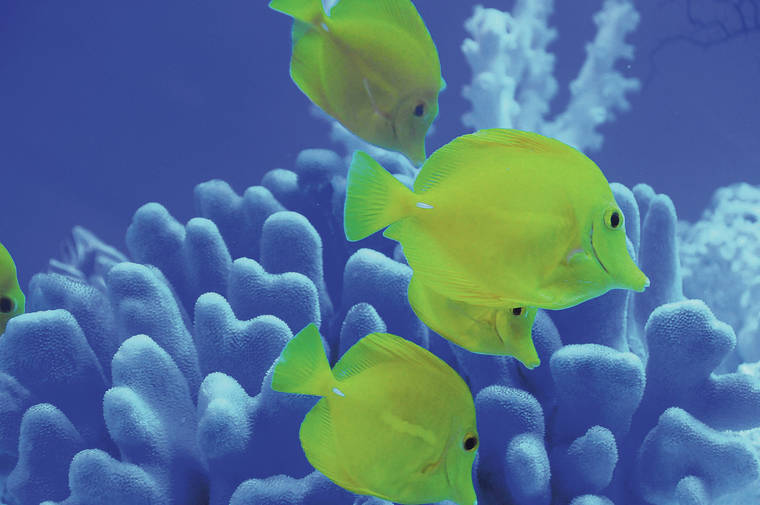A coalition of conservation groups led by Earthjustice said the state has been shirking its duties in cracking down on the illegal collection of aquarium fish from Hawaii ocean waters.
The group — which includes For the Fishes and the Center for Biological Diversity — says the state Department of Land and Natural Resources has continued to allow aquarium fishing without the environmental review required by a state Supreme Court ruling Opens in a new tab in 2017.
Under that ruling, and a subsequent state Circuit Court decision, no aquarium permits are to be issued until a review is completed, according to Earthjustice attorney Mahesh Cleveland. DLNR has circumvented the law by issuing commercial marine licenses instead, and allowing for the collection of aquarium fish, as long as no fine-meshed nets and traps are used, Cleveland said.
“They’re basically sidestepping the Supreme Court ruling and the Circuit Court’s moratorium on new aquarium permits by saying aquarium permits are not even necessary,” said Cleveland.
Instead of embracing the courts’ rulings, Cleveland said, the agency has given the industry “a free pass to continue collecting without any oversight” for the benefit of private profits.
DLNR issued a statement from its Division of Aquatic Resources saying it is complying with the law.
“Under current law, commercial aquarium fishing is allowed as long as collectors have a valid commercial marine license and are using legal gear and methods,” said DAR in a statement. “This is applicable for all areas except West Hawaii, where all aquarium collection is prohibited until an environmental review is completed.”
In 2017 a Hawaii Supreme Court ruling made the use of fine-mesh nets illegal for the commercial collection of aquarium fish until an environmental review is done. Fine-mesh nets are the primary tool for aquarium fishing.
An Oahu Circuit Court subsequently ordered the state not to issue any new permits Opens in a new tab until environmental reviews were completed.
Previously, DLNR required both an aquarium permit and commercial marine license regardless of type of gear used, said Cleveland, but began accepting only the latter after the ruling.
“They basically decided that aquarium permits are not required as long as the collectors are allegedly not using fine-mesh traps and nets,” said Cleveland.
Earthjustice estimates commercial collectors have taken at least 576,741 individual animals — 372,769 fish and 203,972 aquatic invertebrates, which include hermit crabs and sea cucumbers — from the state’s surrounding ocean for aquarium purposes.
These were self-reported by collectors statewide for a two-year period between October 2017 and October 2019, according to Earthjustice.
The aquarium permit statue has been in place since 1953, according to Cleveland, to ensure that people capture aquarium fish alive and in reasonable health.
Without that permit, he said, “now you just have people taking tiny fish off the reef with no oversight over whether they’re being kept alive or whether that resource is being wasted.”
Additionally, DLNR is not actively verifying whether collectors are using the methods that they claim to be using, the group alleges.
“It would be extremely difficult to gather the types and amounts of animals that the industry has continued to collect without using fine-meshed gear, which has always been the primary means for gathering aquarium fish,” the coalition said in a news release.
Rene Umberger, executive director of For the Fishes, said prior to the Supreme Court ruling, virtually all fish were captured with a fine-meshed net. The nets allow collectors to surround entire coral heads of communities of fish, then pick out little ones.
The point of the ruling, however, she said, was
not the method of collection, but the unbridled
collection of fish from
Hawaii’s reefs without environmental review.
The yellow tang from Hawaii is the most sought-after fish being collected for commercial use in aquariums, according to Umberger, and one of the most heavily traded in the world.
“They’re not found anywhere else in the world in large numbers,” she said. “Virtually 100% of yellow tangs came from a Hawaii reef.”
Earthjustice is working on the issue on behalf of For the Fishes as well as the Center for Biological Diversity, and cultural practitioners including Willie and Ka‘imi Kaupiko and Mike Nakachi.
The fish collected are primarily reef-dwellers that control algae growth and play other important roles in the coral reef ecosystem, said the coalition, which warned the state that this could end up back in court.
Hawaii’s coral reefs, which are under stress, need all the help they can get, said Umberger.
“I would say at this point because of what’s happening, and projected to happen to Hawaii’s reefs as a result of climate change, these fish are more important now than ever before,” she said. “We literally cannot afford to lose or waste a single fish. They play such key important roles on the reef.”

